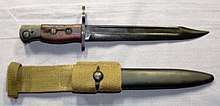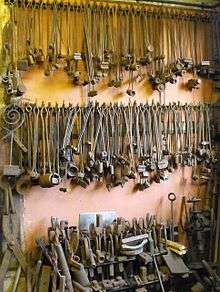Fuller (weapon)
A fuller is a rounded or beveled longitudinal groove or slot along the flat side of a blade (e.g. a sword, knife, or bayonet) that is made using a blacksmithing tool called a spring swage or, like the groove, a fuller. A fuller is often used to lighten the blade. When combined with proper distal tapers, heat treatment and blade tempering, a fullered blade can be 20% to 35% lighter than a non-fullered blade with minimal sacrifice of strength or blade integrity. This effect lessens as the blade is reduced in length. A blade is said to be "fullered" after introduction of the groove.


Fullers used to be called "blood grooves" or "blood gutters" by some antiquarians, although their purpose has nothing to do with blood.
Etymology
The term "fuller" is from the Old English fuliere, meaning "one who fulls (pleats) cloth". It is derived from the Latin word fullo. The first recorded use of the term as a blacksmithing tool is from 1864, according to Webster's Dictionary.[1] The terms "blood channel", "blood groove" echo German Blutrinne, a misleading antiquarian term in use from the 1840s.
Tool

As a blacksmithing tool, a fuller is a type of swage. A swage is a tool that has a particular shape forged into its surface, which is used to imprint that shape into the metal. Swages are often tools with handles and various shaped heads, which are placed between the hammer and the workpiece, allowing the smith to work the steel into various shapes that would be impossible to make with a hammer alone. Swage blocks are often anvil-like blocks with various shapes forged in them, also for forming metal. The term "swage" is from the Old French "souage", meaning "decorative groove" or "ornamental moulding".
Fullers, in particular, are swages that have a cylindrical or beveled face, typically three to six inches long, which are used for imprinting grooves into the steel. If a groove is to be applied to both sides of the steel, two fullers may be used at the same time, sandwiching the workpiece in the middle. Often, one fuller will have a peg that holds it securely in the anvil, while the other fuller will have a handle and a flat head, for striking with a hammer. Sometimes the two fullers may be connected with a flatbar of spring steel which is bent into a wide, "C" shaped bracket, keeping the two fullers aligned with each other and freeing the smith's hands for manipulating the workpiece and hammer. A blade being fullered will generally be slowly pulled through the fullers as they are being hammered, until the entire groove is the proper depth and shape. As the fullers make the groove, they typically displace material to the side, creating ridges around the grooves. These ridges may be hammered flat, widening the blade, or they are often shaped with other swages, increasing the strength of the blade by creating thicker areas in its cross section.
Fullers have a variety of uses beyond bladesmithing. They are often used for "drawing out" steel, which consists of hammering a short block into a long bar. The fullers will often be used to notch the block or bar. If the fullers are longer than the block is wide, they will tend to elongate the block rather than raise bulges from the surface. After notching, the block is hammered smooth, elongating it further, and this process is repeated until the bar becomes the correct length and thickness. Fullers are also used for many other shaping processes in blacksmithing, from making hinges and latches to plow parts and horseshoes.[2]
Japanese blades
In Japanese swordsmithing, fullers have a rich tradition and terminology, enough that there are separate terminologies for the top (hi, usually pronounced as bi when used as a successive word) and bottom (tome) ends of the feature. A listing follows:
- Bo-hi: A continuous straight groove of notable width, known as katana-bi on tantō. With soe-bi, a secondary narrow groove follows the inner straight length of the main one. With tsure-bi, the secondary is similar but continues beyond the straight length.
- Futasuji-hi: Two parallel grooves.
- Shobu-hi: A groove shaped like the leaf of an iris plant.
- Naginata-hi: A miniature bo-hi whose top is oriented opposite from the blade's, and usually accompanied by a soe-hi. Seen primarily on naginatas.
- Kuichigai-hi: Two thin grooves that run the top half of the blade; the bottom half is denoted by the outer groove stopping halfway while the inner one expands to fill the width.
- Koshi-hi: A short rounded-top groove found near the bottom of a blade, near to the tang.
- Tome
- Kaki-toshi: The groove runs all the way down to the end of the tang.
- Kaki-nagashi: The groove tapers to a pointed end halfway down the tang.
- Kaku-dome: The groove stops as a square end within 3 cm of the tang's upper end.
- Maru-dome: Similar to the kaku, except with a rounded-end.
The kukri
The Nepali kukri has a terminology of its own, including the "aunlo bal" (finger of strength/force/energy), a relatively deep and narrow fuller near the spine of the blade, which runs (at most) between the handle and the corner of the blade, and the "chirra", which may refer either to shallow fullers in the belly of the blade or a hollow grind of the edge, and of which two or three may be used on each side of the blade.[3]
References
- "Definition of FULLER". www.merriam-webster.com.
- English Mechanic and World of Science by R. J. Kibblewhite -- Bradley and Co. 1892 Page 53
- "kukri construction". himalayan-imports.com.
- "Blood groove" in the A. G. Russell knife encyclopedia]
- Terminology of the Kukri
- [American blacksmithing by J Holmstrom]
- [The art of blacksmithing by Alex Bealer]